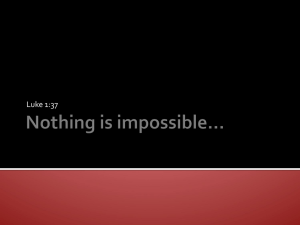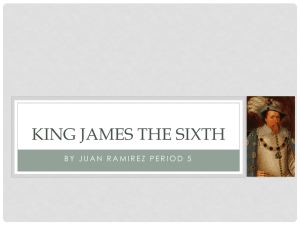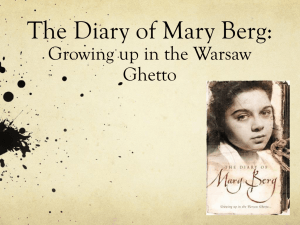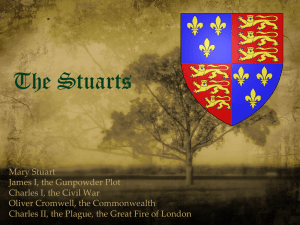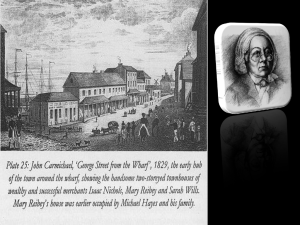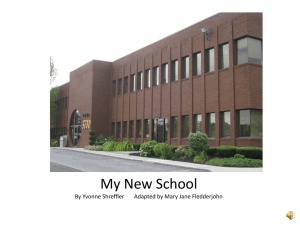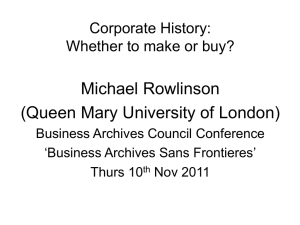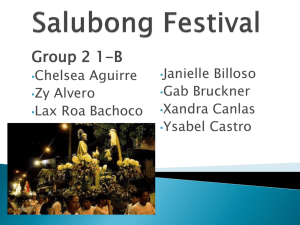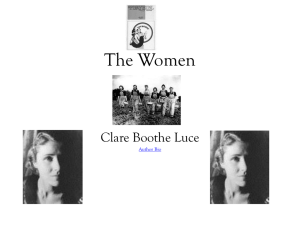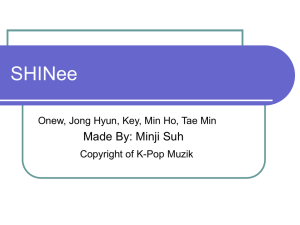`Hieroglyphics` by Anne Donovan
advertisement
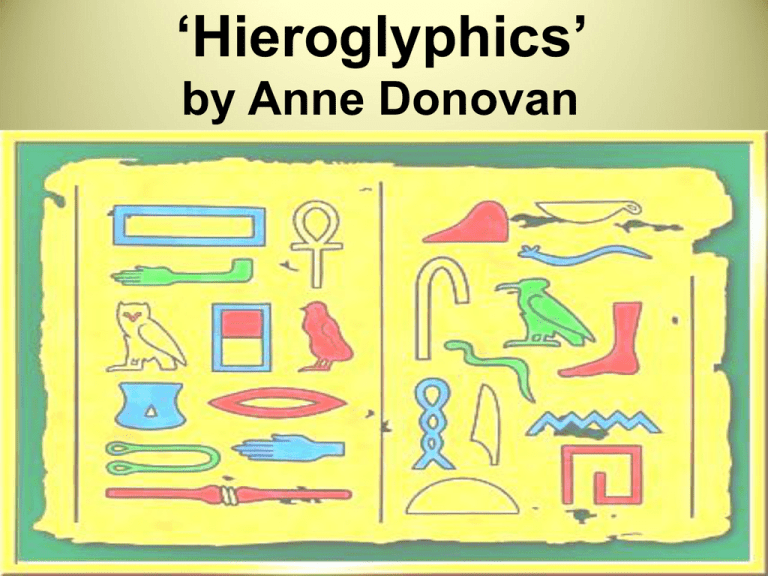
‘Hieroglyphics’ by Anne Donovan ‘Hieroglyphics’ – Ann Donovan Questions 1) How is the story narrated (in which person, who by, using what kind of language) and what effect do you think this has? 2) How does the author show the contrast between the way that Mary speaks and the way that her teachers speak? Quote as evidence. 3) It is clear to us that Mary is dyslexic, although this is never explicitly said. Write down a quote from the start of the story which shows the impact that this is having on her. Now we are going to identify the attitudes that other characters have towards Mary and her learning and look at how this influences the reader’s reactions toward Mary. Key point: all the other characters and their apparent feelings / attitudes towards Mary are all informed from her own perspective. These may not be the actual attitudes / feelings, but this is what Mary interpreted from their actions and words. 4a) Different people respond in different ways to Mary’s difficulties. Write down in your own words (and back up with quotes as evidence) how the following characters treat her: • Her mother • The ‘Remmy wummin’ (Support for Learning teacher) • Her p7 teacher • Most teachers in secondary school • Mr Kelly • The Headteacher • Miss Niven b) Write a comment explaining how each characters’ response makes you feel. 5) How do other pupils start to treat Mary as a consequence of Mr Kelly’s attitude, and how does this make her feel? Quote as evidence. 6) The turning point in the story is when Mary says, ‘wan day ah couldnae take it oany longer’. How does Mary use her creative ability to rebel against Mr Kelly? 7) What does the ending of the story tell us about Mary and her strength of character? Quote as evidence. 8) One of the ways that the author shows us Mary’s intelligence is through the clever imagery which she uses in her narration. Choose three figures of speech which you feel are particularly effective and for each one: • Show that you understand the link between the connotations of the imagery and the literal meaning of the words. • Comment on the effect this image has i.e. how the connotation of the imagery helps to enlarge, or refine your idea of what is being described. POSSIBLE ANSWERS 1) How is the story narrated (in which person, who by, using what kind of language) and what effect do you think this has? The story is narrated in the first person. The character of Mary narrates the story in the Glaswegian dialect of Scots, from the perspective of looking back on her experiences. This mode of narration gives the reader a clear sense of what Mary’s experience is like and allows the reader to feel sympathetic towards the character. POSSIBLE ANSWERS 2) How does the author show the contrast between the way that Mary speaks and the way that her teachers speak? Quote as evidence. Mary does not use Standard English grammar, her tone is chatty and conversational, she uses Scots vocabulary and phonetic spellings to reflect her pronunciation of words. Mary’s narrative reflects the way she speaks and the fact that she has problems reading and writing Standard English: “The class were aw sittin up like circus lions at this point, wonderin whit the ringmaister wis gonny dae next. Sometimes he would launch intae a big long speech and then ye didnae huv tae dae oany work. Which wis hunky dory as long as you wereny the wan he'd lamped oanty.” POSSIBLE ANSWERS 2) How does the author show the contrast between the way that Mary speaks and the way that her teachers speak? Quote as evidence. • The teachers use Standard English grammar and spelling, complex vocabulary and a formal tone: “And since the function of reading is to communicate, what point is there in writing something which is utterly unintelligible?” “Yes, but I'm sure all your paperwork is up to date, and there is evidently splendid work going on in the room. But what is this child doing drawing pictures of Egyptians? Should she not be on to the 'Victory for Democracy' Unit by now?” POSSIBLE ANSWERS 3) It is clear to us that Mary is dyslexic, although this is never explicitly said. Write down a quote from the start of the story which shows the impact that this is having on her and comment on its effect on the reader. “Ah mind they were birlin and dancin roond like big black spiders. A couldnae keep a haunle on them fur every time ah thoat ah'd captured them, tied them thegither in some kindy order they jist kep on escapin.” This creates sympathy from the start and gives a clear sense of the frustration that Mary has to contend with in her life. This simile compares Mary’s ability to read to the difficult and frustrating activity of catching a spider: ‘birlin’ and ‘dancin’ convey the frenzied actions and lack of control that we have when trying to catch a spider and this illustrates the lack of control that Mary has over words on a page; ‘captured’ and ‘escapin’ imply that Mary is in constant conflict with the words but she can never command them. POSSIBLE ANSWERS 4a) Different people respond in different ways to Mary’s difficulties. Write down in your own words and back up with quotes as evidence how the following characters treat her Her mother: • She seems to think that Mary has trouble reading because she is not applying any effort to her work: “She's lazy, ye mean.” “She's eight year auld an she canny read nor write yet.” Her mother is unsupportive – the Primary teacher is clearly trying to point out that there is ‘a genuine difficulty’ preventing Mary from progressing; however, the abrupt interruptions from her mother suggest that she blames Mary for her lack of progress: “She's lazy, ye mean.” The fact that Mary recalls the words of her mother many years after the event demonstrates how much of an influence her mother’s lack of support had on her. POSSIBLE ANSWERS 4a) Different people respond in different ways to Mary’s difficulties. Write down in your own words and back up with quotes as evidence how the following characters treat her Her mother: • Mary believes that her mother thinks she’s stupid (‘daft’) because she is illiterate, but is capable of carrying out practical tasks like shopping, housework etc: “Ma mammy thoat ah wis daft, naw, no daft exactly...Ma mammy knew ah could go the messages an dae stuff roond the hoose and talk tae folk, ah wis jist daft at school subjects, the wans that involved readin or writin oanyway.” The fact that her own mother is so unsupportive and dismissive of her makes us pity her more. POSSIBLE ANSWERS 4a) Different people respond in different ways to Mary’s difficulties. Write down in your own words and back up with quotes as evidence how the following characters treat her The Support for Learning teacher: • She was pleasant to Mary to start with, but Mary feels that she became disgusted, bored or fed up ( “scunnered” ) when Mary was unable to do the work and thought that she was not trying hard enough: “She wis nice tae me at furst but then when ah couldnae dae the hings she wis geein me she began tae get a bit scunnered. A hink she thoat A wis lazy...” This is a shocking attitude for a Learning Support teacher to display and the fact that Mary recognises this attitude in her makes us feel sympathy for her. POSSIBLE ANSWERS 4a) Different people respond in different ways to Mary’s difficulties. Write down in your own words and back up with quotes as evidence how the following characters treat her - Her p7 teacher: • She is pleasant to Mary, but instead of making the effort to work with her to help her overcome her problems with reading and writing, she gives her tasks to keep her busy (like colouring in) and menial jobs to do: “And efter a while the extra lessons stoaped. They were dead nice tae me at school but. Maisty the time the teacher gied me the colourin in tae dae an when ah wis in Primary seven ah goat tae run aw the messages an helped oot wi the wee wans. No wi their readin of course, but gettin their paints mixed an takin them tae the toilet an pittin oot the mulk fur them. • She patronisingly refers to her as her ‘little assistant’: POSSIBLE ANSWERS 4a) Different people respond in different ways to Mary’s difficulties. Write down in your own words and back up with quotes as evidence how the following characters treat her - most teachers in secondary school: • They feel sorry for her, but make no effort to try to teach her because they believe she is incapable of learning anything: “Ah knew whit they were thinkin of me right enough, ah could see it in their eyes, but maisty them jist thoat ah wis a poor wee sowl that couldnae learn oanythin, so whit wis the point a them tryin ae teach me?”... “She's a poor wee soul but she tries very hard.” • Instead of teaching her, the teachers gave her menial tasks to do to keep her busy: “look how neatly Mary's coloured in the borders of the wall display.” POSSIBLE ANSWERS 4a) Different people respond in different ways to Mary’s difficulties. Write down in your own words and back up with quotes as evidence how the following characters treat her – Mr Kelly: • He bullies Mary and ridicules her. Having reviewed her writing, Kelly suggests that it resembles Hieroglyphics and makes himself look clever by embarrassing her: “he hud tae make hissel smart by drawin attention tae me.” • He says in front of the class: “And since the function of reading is to communicate, what point is there in writing something which is utterly unintelligible?” • He makes Mary feel embarrassed and humiliated: “Ah wis mortified, pure mortified” POSSIBLE ANSWERS 4a) Different people respond in different ways to Mary’s difficulties. Write down in your own words and back up with quotes as evidence how the following characters treat her – The headteacher: • He patronises her, talking about her as if she, and the rest of the class, cannot hear him: “She's a poor wee soul but she tries very hard.” • He recognises the effort she applies, but his description of her as a “poor wee soul” shows that he does not think she is capable of learning anything and that she is not worth teaching. POSSIBLE ANSWERS 4a) Different people respond in different ways to Mary’s difficulties. Write down in your own words and back up with quotes as evidence how the following characters treat her – Miss Niven: • She is nice to Mary and encourages her to do something which she enjoys and is good at, drawing hieroglyphics: “And ah turnt oot tae be dead good at it.” She makes her feel special by giving her a pen to do them with: “Miss Niven even gied me a special fine black pen fur daein the outlines... stuck in a coarner a the room wi a pile a libry books roond me, drawin they wee sideyways people wi their big fish eyes... She let me keep the wee fine black pen though, she's dead nice, Miss Niven.” • Although Mary describes her as ‘dead nice’ and she doesn’t humiliate her, like Mr Kelly, neither does she make any effort to actually teach her or help her overcome her problems. Mary is repeatedly failed by others: her mother and her teachers. Even those teachers who are nice to her do not make any effort to help her to overcome her difficulties, instead giving her little jobs to keep her busy, and Mr Kelly bullies and ridicules her. She seems to be very aware of the attitudes of these adults towards her and this builds up a strong sense of sympathy in the reader as she shares her experiences with us. POSSIBLE ANSWERS 5) How do other pupils start to treat Mary as a consequence of Mr Kelly’s attitude, and how does this make her feel? Quote as evidence. • They start to distance themselves from her and isolate her: “And from that day sumpn funny startit tae happen that ah couldnae unnerstaun. The class stopped talkin tae me but it wisnae like they'd aw fell oot wi me...but they widnae say much and they never startit a conversation wi me. And there seemed tae be an empty space aw roond me in the class, fur naebdy sat next tae me if they could help it... And it wisnae jist in his class either, ah could of unnerstood that aw right fur who wants tae sit near the target practice? But it wis in every class, and the playgrund and the dinner school.” POSSIBLE ANSWERS 5) How do other pupils start to treat Mary as a consequence of Mr Kelly’s attitude, and how does this make her feel? Quote as evidence. • Mary feels unhappy and left out of the fun and companionship of school. She likens her situation to being the only one without a partner to dance with: “And when ye move up tae the big school it's a time when friendships kindy shuffle roond like wanny they progressive barn dances, and ye make new wans an ye lose auld wans and somehow in the middly aw this process ah fund masel oot the dance wioot a partner. And it wisnae nice.” • This effectively conveys her sense of isolation and the fact that she has no friends. The short sentence “And it wisnae nice” is an understatement of her feelings. POSSIBLE ANSWERS 5) How do other pupils start to treat Mary as a consequence of Mr Kelly’s attitude, and how does this make her feel? Quote as evidence. Mary’s isolation from her peers adds to the reader’s sense of sympathy for her. POSSIBLE ANSWERS 6) The turning point in the story is when Mary says, ‘wan day ah couldnae take it oany longer’. How does Mary use her creative ability to rebel against Mr Kelly? • Mary is ultimately able to take pride in her class work despite the attitude of her teachers. She decides to show her creative ability by rebelling against Mr Kelly and writing a whole story in her own hieroglyphics: “And then wan day ah couldnae take it oany longer... So ah startit tae write aboot ma journey tae the next world and the hings ah wid take wi me, aw in wee pictures.” POSSIBLE ANSWERS 7) What does the ending of the story tell us about Mary and her strength of character? Quote as evidence. • Mary is ultimately able to take pride in her class work despite the attitude of her teachers. As she collects in the class’s work she sees that the class have ‘aw different kinds of hand writing’ and this realisation that everyone has different abilities encourages her to take pride in her work: “So ah drew a wee picture of masel wi a cheery face on it, pit ma story right on tap ae the pile and planted the whole lot doon in the centre of his desk.” POSSIBLE ANSWERS 7) What does the ending of the story tell us about Mary and her strength of character? Quote as evidence. • The ‘cheery face’ that Mary draws is representative of her feelings of happiness with her work and the sense of achievement that she has gained, while the placement of her work ‘right on the tap’ shows her pride in her work. • This shows how Mary has overcome the negativity of others, worked out how to overcome her problems and become a confident individual. POSSIBLE ANSWERS 8) One of the ways that the author shows us Mary’s intelligence is through the clever imagery which she uses in her narration. Choose three figures of speech which you feel are particularly effective and for each one: Show that you understand the link between the connotations of the imagery and the literal meaning of the words. Comment on the effect this image has i.e. how the connotation of the imagery helps to enlarge, or refine your idea of what is being described POSSIBLE ANSWERS 8) “Ah mind they were birlin and dancin roond like big black spiders. A couldnae keep a haunle on them fur every time ah thoat ah'd captured them, tied them thegither in some kindy order they jist kep on escapin.” • Mary likens the process of trying to read to the frustrating act of trying to catch a spider. • ‘birlin’ and ‘dancin’ convey the frenzied actions and lack of control that we have when trying to catch a spider and this illustrates the lack of control that Mary has over words on a page; ‘captured’ and ‘escapin’ imply that Mary is in constant conflict with the words but she can never command them. The • image shows how difficult and frustrating she finds trying to read. POSSIBLE ANSWERS 8) “he used tae squint at ye through wan eye as if he wis examinin ye through a microscope an hid jist discovered some new strain a bacteria that could wipe oot the entire population a Glesga.” • This image compares the way that Mr Kelly looks at the pupils to the way a scientist would look at a dangerous bacteria under a microscope. • This conveys Mr Kelly’s superior attitude towards the pupils, emphasising how much he looks down on them and the fact that he sees them as unpleasant and something he would like to distance himself from. POSSIBLE ANSWERS 8) “If ye kin imagine the class like a field a racehorses then he wus gaun at such a pelt that only the first two or three could keep up wi him. The rest wur scribblin furiously, their airms hingin oot thur soackets, sighin an moanin ower their jotters, and then he'd tease them wi a pause that wis jist a toty bit aff bein long enough tae let them catch up, an then, wheech, he wis aff again lik lightnin. Me, A wis the wan that fell at the furst fence.” • This image compares trying to keep up with work in Mr Kelly’s class to taking part in a frantic horse race: the teacher is racing ahead and only a few of the most able pupils manage to keep up with him. He would deliberately wait until the majority of the class had just about caught up, then would carry on without giving them a chance to rest. Mary describes herself as the “wan that fell at the furst fence” . POSSIBLE ANSWERS 8) CONT./ • This image reinforces how mean Mr Kelly is as he sees to be deliberately tormenting most of the pupils by making it impossible for them to keep up. • Mary’s difficulties are highlighted by the fact that she is so far behind the others she is like a horse that does not even manage to jump over the first fence - the fence symbolises her literacy problems which stops her from having any hope of keeping up with the rest of the class. • The description of the race is in one long sentence with several commas, emphasising the endless struggle of most of the class to keep up. In contrast, Mary’s immediate failure is emphasised by using an abrupt, short, one sentence paragraph. • • This image highlights Mary’s sense of failure and increases our sympathy for her. POSSIBLE ANSWERS 8) “The class were aw sittin up like circus lions at this point, wonderin whit the ringmaister wis gonny dae next” This image likens Mr Kelly to a circus ringmaster and the class to lions under his control. This suggests the tension in the class and that the other pupils are potentially harmful (as shown when they start to ignore Mary and isolate her). It also shows that Mr Kelly enjoys controlling them and enforcing his power over them and enjoys showing off for his audience. POSSIBLE ANSWERS 8) “And when ye move up tae the big school it's a time when friendships kindy shuffle roond like wanny they progressive barn dances, and ye make new wans an ye lose auld wans and somehow in the middly aw this process ah fund masel oot the dance wioot a partner. And it wisnae nice.” • This metaphor compares making new friends at school to taking part in a dance – everyone pairs up with new friends, but Mary has been left without a dance partner / friend. • This image is effective in suggesting that Mary, by missing out on friendships, is missing out on the fun that school has to offer. The word ‘dance’ suggests fun, happiness and moving around in partnerships. However, Mary is missing out on this. The simplicity of the sentence ‘And it wisnae nice’ is really an understatement as to how she feels. This makes us understand that not only does her learning difficulty have educational implications, but also social implications. POSSIBLE ANSWERS 8) “Ma writin looked a bit like wee scarab beetles scurryin aboot the page and when he corrected it, it wis as if the wee beetles hud aw startit bleedin.” • This simile likens Mary’s writing to scarab beetles, and the corrections made on it to blood coming from the beetles. • This emphasises how messy, random and unintelligible her writing looks, and links to the story’s title and content as scarab beetles are linked to ancient Egypt. The corrections made by Mr Kelly, presumably in red pen, cover the page and the reference to blood suggests how painful the process of writing is for Mary, and how demoralising it is for her to see all these corrections.
